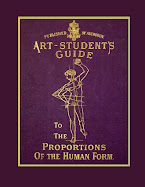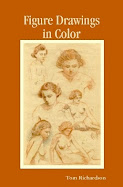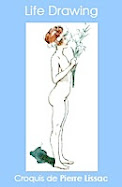(ABOUT 50,000)
IN EVERY DEPARTMENT OF SCIENCE ART AND LITERATURE
WITH THE DATES OF THE FIRST AND LAST EDITIONS
AND THE PRICE SIZE AND PUBLISHERS NAME OF EACH BOOK
By William Swan Sonnenschein
This listing of the best books on Artistic Anatomy from 1891 lists a couple of republished books available for purchase.
 Dr. G. Schadow's The Sculptor & Art Student's Guide to the Proportions of Human Form as available at Amazon.com as:
Dr. G. Schadow's The Sculptor & Art Student's Guide to the Proportions of Human Form as available at Amazon.com as:The Art Student's Guide to the Proportions of the Human Form
Or download a copy at Figure-Drawings.com.
 Another book by Dr. Schadow:
Another book by Dr. Schadow:The Art Student's Guide to the Bones and Muscles of the Human Body and Lessons on Foreshortening
 Dr. J. Fau's Anatomy of the External Forms of Man is available both at Lulu.com and at Amazon.com as:
Dr. J. Fau's Anatomy of the External Forms of Man is available both at Lulu.com and at Amazon.com as:Anatomy for Art Students, Painters and Sculptors
Or download a copy at Figure-Drawings.com.
Some more references about Johann Gottfried Schadow:
From Johnson's Universal Cyclopedia: a new edition - By Johnson, A. J., company, A.J. Johnson Company, 1895
Schadow, Johann Gottfried : sculptor; b. in Berlin, May 20, 1764; studied drawing and sculpture in his native city and at Rome 1785-87, and was appointed professor at the Academy of Art in Berlin in 1788. His life was spent chiefly at Berlin from this time on, but he traveled much, especially in Italy. His style is founded upon classical traditions. His principal works are statues of Frederick the Great, in Stettin ; Leopold of Dessau, in Ziethcn, and the Count de la Marck, in Berlin ; Luther, in Wittenberg; the monument of Marshal Blilcher, at Rostock ; and a number of busts, some of which are in the Walhalla on the Danube near Ratisbon, etc. He also modeled the quadriga over the Brandenburg gate of Berlin, and a frieze on the outside of the mint in that city. D. in Berlin, Jan. 27, 1850.
From A History of European and American Sculpture from the early Christian Period to the Present Day, Volume 2, By Chandler Rathfon Post, Cambridge, Harvard University Press and London, Humphrey Milford, Oxford University Press, 1921:
The most prominent German sculptor of the neoclassic period, Johann Gottfried Schadow (1764-1850), transports us from southern Germany to Berlin. It is necessary to describe Schadow as "of the neoclassic period," and not as essentially neoclassic himself, since, although inevitably somewhat influenced by the rococo style of his youth and by the prevalent antiquarianism, he was, in his lesser degree like Houdon, independent of any movement, and recognized as his guides only nature and his own conceptions. If he must be assigned to any tendency, it would be to the rococo. His naturalism is, of course, more in harmony with this style; and he may be described, especially in his feminine figures, as a belated and highly individual representative of the eighteenth century, with that increasing interest in the antique which marked so much of the sculpture in the second half of the century. Born in Berlin, he was apprenticed to Tassaert, who, as a rococo artist, had a more enduring effect upon Schadow than has usually been recognized. Having made a romantic marriage, he obtained enough money from his father-in-law to spend the coveted period of study in Italy, where he was influenced by the art of the Cinquecento as well as by the antique. In 1788 he returned to Berlin as court sculptor, and although Frederick the Great had died two years before, Schadow's works embodied not only the pride of that monarch's epoch but also, stylistically, the curious fusion of French rococo taste with German solidity exemplified by Frederick himself. His position corresponded to that of Schluter under Frederick I, but his lack of full sympathy with neoclassicism or with the later romanticism cost him his popularity, so that the great body of his production falls within the space of about twenty years from the time of his appointment. In 1791 he made a journey to Copenhagen, Stockholm, and Petrograd to learn bronze-casting, but the more important effect of this event was the acquisition of inspiration by acquaintance with monuments executed with historical realism and not according to the bald principles of neoclassicism.
He approached nearest to the neoclassic in his early decoration of the Parolesaal and the yellow Pfeilersaal of the Royal Palace at Berlin, in the copper Quadriga driven by Victory, the metopes of the Centaurs and Lapithae, and the resting Mars, all on the Brandenburg Gate, Berlin, and in his last work in marble, the recumbent maiden now in the National Gallery, Berlin. But these suggest almost as much the French eighteenth century as they do the antique, and in fact belong to neither one style nor the other. They are rather the outcome of Schadow's personal style, in which now reminiscences of one epoch are apparent, now those of another, but which remains nevertheless essentially his own and is permeated by naturalism. His feminine forms are even more real than those of Dannecker; one has only to compare the Sappho of the latter with the above-mentioned recumbent maiden.
Perhaps the most striking instances of his realism, all with contemporary military uniforms, are the statues of the generals Ziethen and Leopold von Dessau, now in the Kaiser Friedrich Museum, and the statuette of Frederick the Great accompanied by two dogs in the Hohenzollern Museum at Berlin. The reliefs on the pedestal of the Ziethen monument, representing battle scenes, reject the laws of neoclassicism by indulging, as also on the Tauentzien monument at Breslau, in pictorial perspective. At other times, especially in his late works, the reliefs for his monument to Bliicher at Rostock and the relief of the apotheosis of Queen Louise in the church at Paretz, he was curiously archaeological in his avoidance of pictorial perspective. In the representation at Rostock of the battle of Ligny, for instance, the main episode of Bliicher lying under a horse and protected by the genius of Germany is set at the bottom of the relief, and the details of the cavalry battle, which ought to be in the background, are simply placed, as in certain ancient reliefs, at a higher level, with the figures in slightly smaller compass; and even the fall of Bliicher is treated with ancient conventionalism. Both at Rostock and Paretz, the elaborate allegories are due to literary interference — in the Bliicher monument that of Goethe.
His many portrait busts, as was to be expected, are convincing pieces of realism in the manner rather of the best eighteenth-century work: notable examples are the Frederick the Great (formerly in the possession of the Kaiser), the Princess Louise (in the National Gallery, Berlin), and the rector Meierotto (in the Joachimsthaler Gymnasium at Berlin). The dead are usually clothed in antique garb, the living in contemporary costume. His neoclassic leanings are revealed, however, in the fact that he is said to have modelled first an ideal head for his portraits and then to have accommodated the individual's features to it. His most renowned work is the standing portrait group of the two sisters, the princesses Louise and Friederike of Prussia in the Palace at Berlin (Fig. 152). He has attained that agreeable fusion of naturalism, even in small details, and ancient grace, which is often to be discerned, with the naturalism less dominant, in the production of Dannecker, and which was much assisted by the similarity of the fashionable Empire costume to that of ancient Rome. The same manner is found in other achievements of Schadow, as in the mourning widow, suggested perhaps by the Agrippina statue, upon the tomb of Count Arnim at Boitzenburg and in the sepulchral figure of the nine year old Count von der Mark on his tomb in the Dorotheen-Kirche, Berlin. This early and famous work depended for its ideas upon the painter Puhlmann and had been ordered first from Tassaert. Although all its forms and elements are neoclassic and reflect Schadow's recent sojourn at Rome, it belongs more or less to the dramatic type of mausoleum of the eighteenth century: the relief on the sarcophagus represents Death or Time dragging the boy away from the school of Minerva to Hades, and in a niche above the sarcophagus sit the three Fates deciding his destiny. Schadow's tombs, however, like the majority of those of the period in Germany, are normally of the sentimental, less complicated, neoclassic type with urn, bust or medallion, and colder allegorical figures, posing but comparatively inactive. Characteristic is the Darjes monument on the "Anger" at Frankfort on the Oder. His naturalism rescued the allegorical figures from the absolute frigidity of the ordinary neoclassicist, and bestowed upon them that French rococo loveliness which is so potent an ingredient of the charm in the portrait group of the two royal sisters.
From The Encyclopaedia Britannica: Eleventh Edition, Volume 24
SCHADOW, a distinguished name in the annals of German art.
I. Johann Gottfried Schadow '(1764-1850), sculptor, was born and died in Berlin, where his father was a poor tailor. His first teacher was an inferior sculptor, Tassaert, patronized by Frederick the Great; the master offered his daughter in marriage, but the pupil preferred to elope with a girl to Vienna, and the father-in-law not only condoned the offence but furnished money wherewith to visit Italy. Three years' study in Rome formed his style, and in 1788 he returned to Berlin to succeed Tassaert as sculptor to the court and secretary to the Academy. Over half a century he produced upwards of two hundred works, varied in style as in subjects.
Among his ambitious efforts are Frederick the Great in Stettin, Blucher in Rostock and Luther in Wittenberg. His portrait statues include Frederick the Great playing the flute, and the crown-princess Louise and her sister. His busts, which reach a total of more than one hundred, comprise seventeen colossal heads in the Walhalla, Ratisbon; from the life were modelled Goethe, Wieland and Fichte Of church monuments and memorial works thirty are enumerated; vet Schadow hardly ranks among Christian sculptors. He ia claimed by classicists and idealists: the quadriga on the Brandenburger Tor and the allegorical frieze on the facade of the Royal Mint, both in Berlin, arc judged among the happiest studies from the antique. Schadow, as director of the Berlin Academy, had great influence. He wrote on the proportions of the human figure, on national physiognomy, &c.; and many volumes by himself and others describe and illustrate his method and his work.

Dr. Schadow's own book Kunst-werke und Kunst-Ansichten is available for viewing at Google Books.
By Johann Gottfried Schadow



















No comments:
Post a Comment